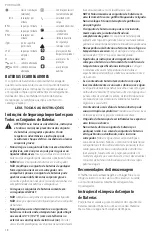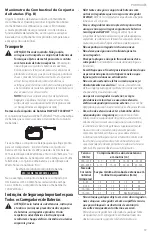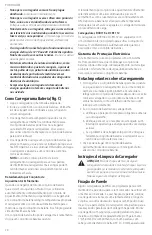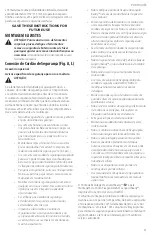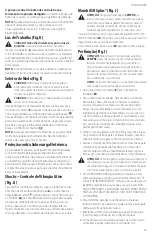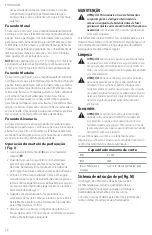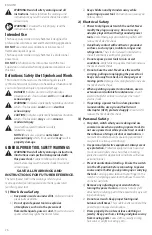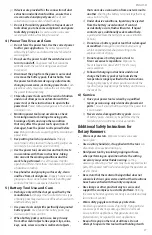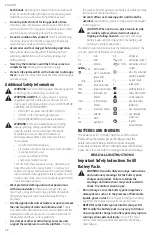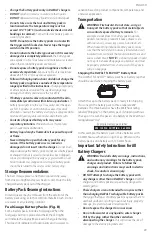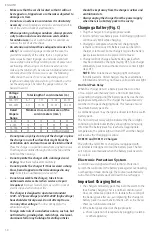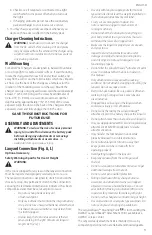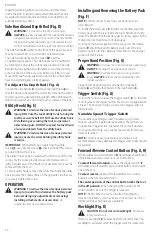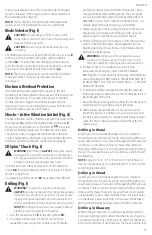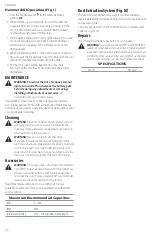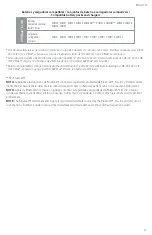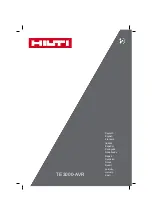
ENglIsh
32
OPERATION
WARNING: To reduce the risk of serious personal
injury, turn unit off and remove the battery pack
before making any adjustments or removing/
installing attachments or accessories.
An
accidental start‑up can cause injury.
Utility Hook (Fig. E)
WARNING: To reduce the risk of serious personal
injury, ONLY use the tool’s ultilty hook to hang the
tool from a work belt. DO NOT use the ultilty hook
for tethering or securing the tool to a person or
object during use. DO NOT suspend tool overhead
or suspend objects from the ultilty hook.
WARNING: To reduce the risk of serious personal
injury, ensure the screw holding the ultilty hook
is secure.
IMpoRTaNT:
When attaching or replacing the ultilty
hook
11
, use only the screw
13
that is provided. Be sure to
securely tighten the screw.
The ultilty hook can be be attached to either side of the tool
using only the screw provided, to accommodate left‑ or
right‑ handed users. If the hook is not desired at all, it can be
removed from the tool.
To move ultilty hook, remove the screw that holds the ultilty
hook in place then reassemble on the opposite side. Be sure
to securely tighten the screw.
Side Handle and Depth Rod (Fig. D)
WARNING:
To reduce the risk of personal injury,
ALWAYS
operate the tool with the side handle properly
installed. Failure to do so may result in the side handle
slipping during tool operation and subsequent loss of
control. Hold tool with both hands to maximize control.
The side handle
1
clamps to the front of the gear case and
may be rotated 360˚ to permit right‑ or left‑hand use.
The side handle clamps to the collar
18
and has
12 tightening locations. The side handle can be tightened
by rotating the grip of the side handle clockwise. The side
handle must be tightened sufficiently to resist the twisting
action of the tool if the accessory bind or stall. Be sure you
moved the side handle against the end of the collar end to
have the clamping piece fully engaged.
To Adjust the Depth Rod (Fig. A)
Loosen the side handle
1
and move the depth rod
2
so
that the distance between the end of the rod and the end of
the bit equals the desired drilling depth. When drilling with
depth rod, stop when end of rod reaches surface of material.
Worklight (Fig. K)
CAUTION: Do not stare into worklight.
Serious eye
injury could result.
There is a worklight
7
located on the front of the tool. The
worklight is activated when the trigger switch is depressed,
Forward/Reverse Control Button (Fig. A, H)
A forward/reverse control button
4
determines the direction
of bit rotation and also serves as a lock‑off button.
To select forward rotation,
release the trigger switch
3
and depress the forward/reverse control button on the right
side of the tool.
To select reverse,
depress the forward/reverse control
button on the left side of the tool.
The center position of the control button locks the tool
in the off position.
When changing the position of the
control button, be sure the trigger is released.
NoTE:
The first time the tool is run after changing the
direction of rotation, you may hear a click on start up. This is
normal and does not indicate a problem.
Trigger Switch (Fig. A)
To turn the tool on, squeeze the trigger switch
3
. To turn the
tool off, release the trigger switch. Your tool is equipped with
a brake. The chuck will stop as soon as the trigger switch is
fully released.
Variable Speed Trigger Switch
The variable speed trigger switch enables you to select
the best speed for a particular application. The farther you
squeeze the trigger switch, the faster the tool will operate.
For maximum tool life, use variable speed only for starting
holes or fasteners.
NoTE:
Continuous use in variable speed range is not
recommended. It may damage the trigger switch and should
be avoided.
Proper Hand Position (Fig. G)
WARNING:
To reduce the risk of serious personal injury,
ALWAYS
use proper hand position as shown.
WARNING:
To reduce the risk of serious personal
injury,
ALWAYS
hold securely in anticipation of a
sudden reaction.
Proper hand position requires one hand on the main
handle
6
, with the other hand on the side handle
1
.
Installing and Removing the Battery Pack
(Fig. F)
NoTE:
For best results, make sure your battery pack is
fully charged.
To install the battery pack
7
into the tool handle, align the
battery pack with the rails inside the tool’s handle and slide
it into the handle until the battery pack is firmly seated in the
tool and ensure that it does not disengage.
To remove the battery pack from the tool, press the release
button
9
and firmly pull the battery pack out of the tool
handle. Insert it into the charger as described in the charger
section of this manual.
regarding working with tools in and around machinery
and “at height”. A lanyard‑ready attachment kit may only
be added to certain models and must be installed by an
authorized service center.
Summary of Contents for DCH172
Page 5: ...3 Fig J Fig L Fig H Fig K Fig M Fig I 12 4 7 15 14 16 5 17 ...
Page 37: ......
Page 38: ......

